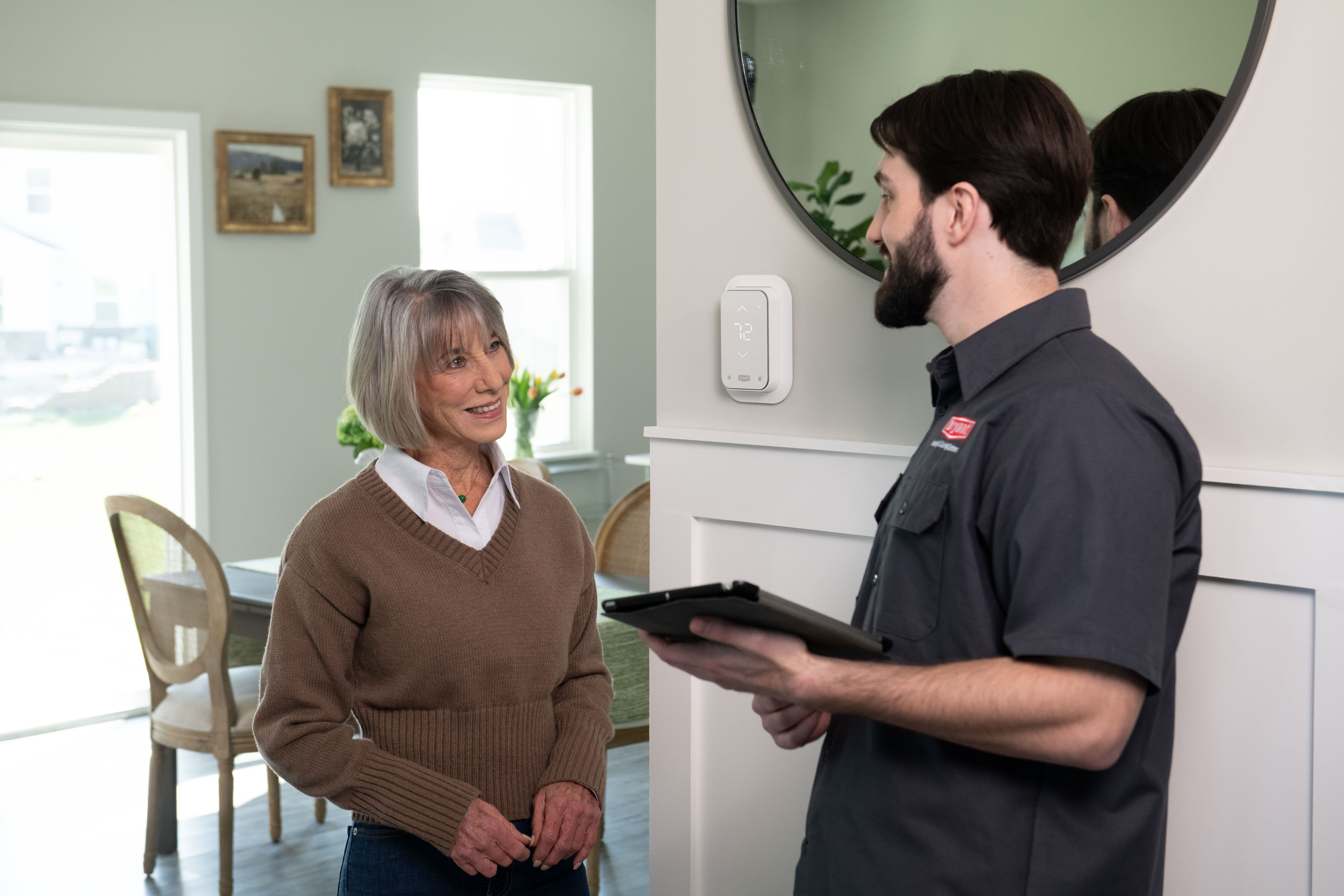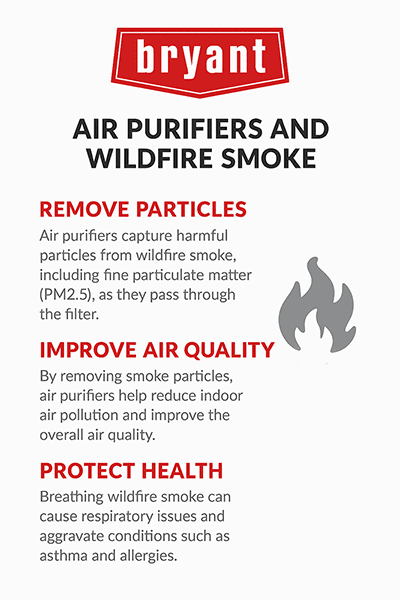About The Author: Travis Baugh is a Digital Brand Marketing Manager for Bryant, where he creates clear, helpful content to guide homeowners through heating, cooling, and indoor air quality decisions. His goal is to empower readers with the knowledge they need to choose the right comfort solutions for their home—confidently and comfortably.
Best Air Purifiers for Wildfire Smoke: A Complete Guide
Wildfire smoke can travel far beyond burn areas, carrying fine particles and odors into homes and lingering indoors even after skies appear clearer. If you’re searching for the best air purifier for wildfire smoke, Bryant offers advanced air purifier solutions designed to help improve indoor air quality when outdoor conditions are at their worst. Learn more about how an air purifier can help combat the effects of wildfire smoke.
Understanding Wildfire Smoke and Its Effects
Wildfire smoke contains a complex mix of gases and microscopic particles produced when vegetation and building materials burn. The most concerning indoor component is fine particulate matter (PM2.5)—particles 2.5 microns and smaller that can travel deep into the lungs and, in some cases, enter the bloodstream. Smoke also includes ultrafine particles, black carbon (soot), and volatile organic compounds (VOCs), all of which can contribute to odors and irritation and may persist indoors if not effectively managed. During intense events, many households seek the best air purifier for forest fire smoke or an air purifier for forest fire smoke to help manage these contaminants.
Short-term exposure to indoor wildfire smoke can lead to coughing, sore throat, watery eyes, headaches, and fatigue. Vulnerable groups—including children, older adults, and people with asthma, COPD, heart disease, or allergies—face increased risks of aggravated respiratory issues and cardiovascular stress. Even healthy individuals may experience reduced lung function, sinus irritation, or disrupted sleep when indoor PM2.5 levels rise. Because smoke particles are extremely small, they can infiltrate through tiny gaps and remain suspended in the air, making indoor air quality management essential during wildfire events. Choosing the best air purifier for wildfire smoke or the best air purifiers for wildfire smoke can support cleaner indoor air when outdoor conditions worsen.
Air purification adds an important layer of protection when outdoor air quality declines. Bryant offers air purifier solutions designed to capture and reduce airborne particles associated with wildfire smoke, including PM2.5 and certain airborne pollutants. By integrating high-efficiency filtration into your home’s HVAC system or using a dedicated whole-home air purifier, you can help lower particle concentrations across multiple rooms, support more consistent comfort, and maintain cleaner indoor air while keeping windows closed. With proper sizing, sealing, and filtration performance, a Bryant air purifier can make a noticeable difference in day-to-day comfort and well-being during smoke events, and stands out as an air purifier for wildfire smoke trusted by many homeowners.
How Air Purifiers Work Against Wildfire Smoke
When wildfire smoke enters your home, microscopic particles and gaseous byproducts can linger and settle on surfaces. An air purifier for wildfire smoke should capture fine particulates efficiently while moving enough air to treat the space. Bryant air purifiers are engineered to address both needs, pairing high-performance filtration with robust airflow to help restore cleaner, fresher indoor air during smoke episodes—qualities you expect from the best air purifiers for wildfire smoke. Learn all about what does an air purifier do.
MERV filters play a central role in smoke removal. MERV stands for Minimum Efficiency Reporting Value, a rating that indicates how effectively a filter captures particles of different sizes. Because wildfire smoke is dominated by fine particles in the PM2.5 range, higher MERV-rated filters are recommended for effective capture. Bryant whole-home air purifiers and compatible furnace filters are available with high MERV ratings designed to capture these fine particulates, helping reduce the concentration of smoke particles that can irritate eyes, throat, and lungs. When paired with proper system sealing and professional installation, a high-MERV solution can maintain strong filtration performance without unnecessary airflow restrictions—important for anyone seeking the best air purifier for wildfire smoke or the best air purifier for forest fire smoke.
Clean Air Delivery Rate (CADR) reflects how quickly an air purifier reduces airborne particles and is an important consideration in smoke events. A higher CADR indicates more air is cleaned in less time. Bryant designs prioritize efficient filtration and strong airflow to deliver robust clean air output, supporting faster, more noticeable improvements when outdoor air quality deteriorates due to wildfires. Matching CADR to your home size and usage patterns helps ensure your purifier delivers the performance you expect, especially when evaluating the best air purifiers for wildfire smoke.

Top Bryant Air Purifiers for Wildfire Smoke
When wildfire smoke impacts outdoor air quality, Bryant offers whole-home solutions designed to help reduce smoke-related particles and odors inside your home. Our purifiers integrate with many Bryant HVAC systems and feature filtration targeted at fine particulate matter commonly found in wildfire smoke, with options to enhance odor control.
Bryant whole-home air purifiers work with your existing heating and cooling system, treating air as it circulates through your ductwork. This approach helps capture microscopic particles throughout every room connected to the system, improving indoor air quality consistently.
The Bryant DGAPA is a whole-home air purifier integrated into your HVAC system. It utilizes a MERV 15 filter, which efficiently captures up to 95% of airborne particles, including fine particulate matter (PM2.5) found in wildfire smoke. Additionally, its Captures & Kills® technology inactivates select airborne pathogens, enhancing overall indoor air quality.
The Bryant UVCAP is designed to address odors and volatile organic compounds (VOCs) associated with wildfire smoke. It combines a carbon core to adsorb harmful gases and odors with ultraviolet (UV) light to reduce microbial growth on the cooling coil. This dual treatment helps maintain a healthier indoor environment during smoke events.
Tips for Maximizing Air Purifier Efficiency
Routine maintenance preserves performance. Monitor your model’s filter indicator and follow Bryant’s recommended replacement intervals based on usage. During wildfire season, elevated particle levels can saturate filters more quickly, so inspect them more frequently for discoloration or odor. Pre-filters may benefit from gentle vacuuming to remove larger debris, extending the life of the primary filter. Always power down and consult the owner’s manual before servicing. Using genuine Bryant replacement filters helps maintain tested CADR and overall performance, ensuring the clean air output you rely on—especially if you’re aiming for the best air purifier for wildfire smoke or the best air purifier for forest fire smoke.
Complement purification with smoke-reduction habits. Keep windows and doors closed during smoke advisories, set your HVAC system to recirculate, and seal obvious gaps around doors and windows. Avoid indoor activities that add particles, such as burning candles, high-heat frying, or using wood-burning fireplaces. During peak smoke hours, consolidate time in a designated clean room with your Bryant air purifier running at a higher fan setting. These steps, combined with advanced filtration and smart features, can help create a cleaner, more comfortable indoor environment when outdoor air quality declines—making your air purifier for wildfire smoke even more effective.
Connect With A Bryant Dealer on Air Purifiers For Wildfire Smoke
Wildfire smoke can impact indoor air quality even miles from the fire itself. A Bryant dealer can help you evaluate your home’s needs and recommend the right air purifier—whether a whole-home DGAPA system, a UVCAP unit for odors and gases, or a combination of both. With professional guidance, you can choose the solution that effectively reduces smoke particles, odors, and other pollutants, keeping your home healthier and more comfortable during wildfire season. Schedule an appointment with your local Bryant dealer today.
Air Purifier For Wildfire Smoke FAQs
Air purifiers with high-MERV filters (MERV 13–16) are effective at capturing fine smoke particles and soot. Units that combine MERV filtration with activated carbon or other odor-control media are best for wildfire smoke. Proper sizing and airflow are also key for efficient particle removal.
Look for a high-MERV filter for fine particles and activated carbon for odors, and a high CADR or airflow rating. Additional features like sealed housing, filter indicators, and quiet operation improve efficiency and usability during wildfire events.
High-MERV filters can capture a significant portion of fine particulate matter (PM2.5) found in wildfire smoke, helping significantly reduce indoor smoke levels when used in appropriately sized spaces. Effectiveness depends on filter quality, unit placement, and continuous operation.
Yes, but only if the purifier includes activated carbon or gas-phase filtration. While MERV filters capture particles, carbon media adsorbs odor-causing VOCs and smoke fumes, helping reduce lingering smells indoors.
Learn More
- Explore air purifier for mold options
- Understand do air purifiers work?
- Find out how to choose an air purifier for dust
- Read our guide on the best air purifier for allergies
- Explore do air purifiers help with smell
- Discover air purifier benefits



